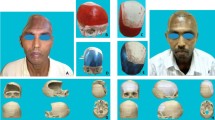Abstract
Purpose
The advantages of rigid fixation over wire osteosynthesis are well established for the management of facial trauma. Miniplates in the frontozygomatic area are traditionally applied to the lateral face of the orbital rim, but with some undesirable effects, such as palpability, visibility, and risk of penetration into the anterior cranial fossa. The aim of this study was to perform an anatomical study to validate the use of miniplates on the temporal face of the frontozygomatic region.
Methods
Osseous thickness measurements were performed in 30 skulls, on four points above and four below the suture, at 3-mm intervals, perpendicular to the bone surface.
Results
There is enough bone thickness to apply the screws, ranging between 4 and 6.5 mm. The first hole over the frontozygomatic suture should receive the smallest screws and the other areas can receive screws up to 6 mm. All drillings are made from the temporal fossa to the orbit, and its contents should therefore be protected during the perforations. At the measured points there is no risk of anterior cranial fossa penetration.
Conclusion
This study suggests that it is possible to use miniplates at the temporal aspect of the frontozygomatic suture.





Similar content being viewed by others
References
Zachariades N, Mezitis M, Anagnostopoulos PD (1998) Changing trends in the treatment of zigomaticomaxillary complex fractures: a 12 year evaluation of methods used. J Oral Maxillofac Surg 56:1152–1156
Rowe NL, Williams LIJ (1985) Maxillofacial injuries, vol. I. Churchill Livingstone, Edinburgh, pp 435–537
Manson PN, Crawley WA, Yaremchuk MJ, Rochman GM, Hoopes JE, French JH Jr (1985) Midface fractures: advantages of immediate extended open reduction and bone grafting. Plast Reconstr Surg 76:1–12
Kaastad E, Freng A (1989) Zygomatico-maxillary fractures. Late results after traction-hook reduction. J Craniomaxillofac Surg 17:210–214
Michelet FX, Deymess J, Dessus B (1973) Osteosynthesis with miniaturized screwed plates in maxillo-facial surgery. J Maxillofac Surg 1:79–84
Vesper M (1996) Der infraorbitale Zugang bei Jochbeinfrakturen. In: Schmelzle R, Bschorer R (eds) Plastische und Wiederherstellungschirurgie—ein Jahrbuch. UNI-MED, Lorsch, pp 181–185
Zide MJ, Wu J (1990) The placement of screws above the zygomaticofrontal suture. J Oral Maxillofac Surg 48:813–816
Ewers R (1977) Periorbitale Knochenstrukturen und ihre Bedeutung für die Osteosynthese. Fortschr Kiefer Gesichtschir 22:45–46
Reher P, Duarte GC (1994) Miniplates in the frontozygomatic region. An anatomic study. Int J Oral Maxillofac Surg 23:273–275
Gruss JS (1996) Discussion: the role of microfixation in malar fractures: a quantitative biophysival study. Plast Reconstr Surg 97:351–353
Krumholz K, Niederhagen B, Lepentsiositis J (1991) Zur Therapie isolierter Jochbeinfrakturen. In: Schwenzer N, Pfeifer G (eds) Fortschritte der Kieferund Gesichtschirurgie, vol. 36. Thieme, Stuttgart, pp 112–114
O’Sullivan ST, Panchal J, O’Donoghue JM, Beausang ES, O’Shaughnessy M, O’Connor TP (1998) Is there still a role for traditional methods in the management of fractures of the zygomatic complex? Injury 29:413–415
Gruss JS, Van Wyck L, Phillips JH, Aantonyshyn O (1990) The importance of the zygomatic arch in complex midfacial fracture repair and correction of posttraumatic orbitozygomatic deformities. Plast Reconstr Surg 85:878–890
Luhr HG (1988) A microsystem for craniomaxillofacial skeletal fixation. J Craniomaxillofac Surg 16:312–314
Fonseca RJ (1998) Discussion: changing trends in the treatment of zigomaticomaxillary complex fractures: a 12 year evaluation of methods used. J Oral Maxillofac Surg 56:1156–1157
Enislidis G, Lagogiannis G, Wittwer G, Glaser C, Ewers R (2005) Fixation of zygomatic fractures with a biodegradable copolymer osteosynthesis system: short- and long-term results. Int J Oral Maxillofac Surg 34:19–26
Suuronen R, Haers PE, Lindqvist C, Sailer HF (1999) Update on bioresorbable plates in maxillofacial surgery. Facial Plast Surg 15:61–72
Berman PD, Jacobs JB (1991) Miniplate fixation of zygomatic fractures. Head Neck 13:424–426
Schilli WG (1990) Treatment of zygoma fractures. Oral Maxillofac Surg Clin North Am 2:155–169
Dal Santo F, Ellis E 3rd, Throckmorton GS (1992) The effects of zygomatic complex fracture on masseteric muscle force. J Oral Maxillofac Surg 50:791–799
Kovács AF, Ghahremani M (2001) Minimization of zygomatic complex fracture treatment. Int J Oral Maxillofac Surg 30:380–383
Davidson J, Nickerson D, Nickerson B (1990) Zygomatic fractures: comparison of methods of internal fixation. Plast Reconstr Surg 86:25–32
Mitchell DA, MacLeod SP, Bainton R (1995) Multipoint fixation at the frontozygomatic suture with microplates: a technical note. Int J Oral Maxillofac Surg 24:151–152
Bhatt V, Langford RJ (2003) Removal of miniplates in maxillofacial surgery: University Hospital Birmingham experience. J Oral Maxillofac Surg 61:553–556
Author information
Authors and Affiliations
Corresponding author
Rights and permissions
About this article
Cite this article
Chrcanovic, B.R., Cavalcanti, Y.S.L. & Reher, P. Temporal miniplates in the frontozygomatic area—an anatomical study. Oral Maxillofac Surg 13, 201–206 (2009). https://doi.org/10.1007/s10006-009-0173-5
Published:
Issue Date:
DOI: https://doi.org/10.1007/s10006-009-0173-5




